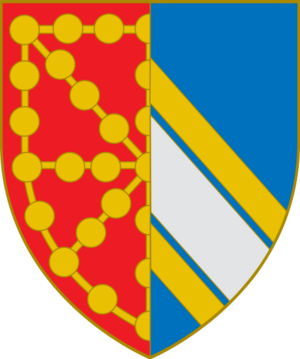Henry I of Navarre facts for kids
Quick facts for kids Henry I |
|
|---|---|
 |
|
| King of Navarre Count of Champagne |
|
| Reign | 1270–1274 |
| Predecessor | Theobald II |
| Successor | Joan I |
| Born | c. 1244 |
| Died | 22 July 1274 Pamplona |
| Burial | Pamplona Cathedral |
| Spouse | Blanche of Artois |
| Issue | Prince Theobald Joan I |
| House | |
| Father | Theobald I of Navarre |
| Mother | Margaret of Bourbon |
Henry I (also known as Henry the Fat) was a powerful ruler in the 13th century. He was the King of Navarre (as Henry I) and the Count of Champagne and Brie (as Henry III). He ruled from 1270 until his death in 1274. People called him "the Fat" because of his large size.
Early Life and Family
Henry was born around 1244. He was the youngest son of Theobald I of Navarre and Margaret of Bourbon.
His older brother, Theobald II, was king before him. Theobald II did not have any children. Because of this, Henry often acted as a regent (someone who rules for the king when the king is away or too young).
In 1269, Henry married Blanche of Artois. She was the daughter of Count Robert I of Artois. Robert was the brother of King Louis IX of France. This marriage connected Henry to important royal families in Europe.
Becoming King
Henry was expected to become king after his brother. When Theobald II died in December 1270, Henry became the new King of Navarre and Count of Champagne.
He was officially announced as king in Pamplona on March 1, 1271. His official crowning ceremony happened later, in May 1273.
One of his first actions as king was to promise to follow the Fueros of Navarre. These were special laws and rights for the people of Navarre. After that, he paid homage to Philip III of France. This was a formal way to show loyalty for his lands in Champagne, which were part of the French kingdom.
Henry's Rule
Henry became king during a good time for Navarre's economy. The region was growing much faster than other parts of Spain.
However, there was a challenge with trade. The Treaty of Paris (1259) had given the English control over Gascony. This area blocked Navarre's direct access to the ocean.
Henry worked to help his cities grow. He gave special rights to towns like Estella, Los Arcos, and Viana. He also allowed a part of Pamplona called Navarrería to become more independent.
He generally had good relationships with the nobles in his kingdom. He wanted to keep peace in his lands.
Henry tried to get back land that Castile had taken from Navarre. He thought about helping King Alfonso X of Castile's brother, Philip, in a revolt. But Henry decided not to. Instead, he tried to make an alliance with Castile.
He planned for his son, Theobald, to marry Alfonso X's daughter, Violant. This marriage was set for September 1272. Sadly, this plan failed. Young Theobald died in 1273 after falling from a battlement (a wall) at the castle of Estella.
Death and Legacy
Henry did not live long after his son's death. He passed away on July 22, 1274. Some historical accounts say he died because of his large size.
His only surviving child was a daughter named Joan. She was only one year old when Henry died. Her mother, Blanche, ruled as regent for her.
In 1284, Joan married Philip the Fair. Philip later became the King of France. This marriage joined the crown of Navarre with the crown of France. Champagne also became part of the French royal lands.
The famous writer Dante Alighieri mentioned Henry in his book, Divine Comedy. Dante saw Henry's spirit outside the gates of Purgatory. Henry is described as "the kindly-faced" and "the father-in-law of the Plague of France."
See also
 In Spanish: Enrique I de Navarra para niños
In Spanish: Enrique I de Navarra para niños


